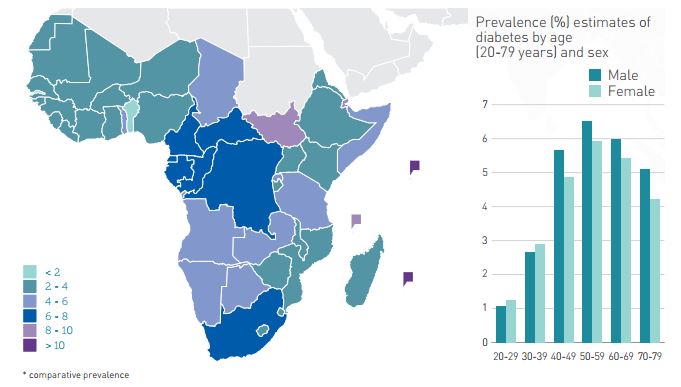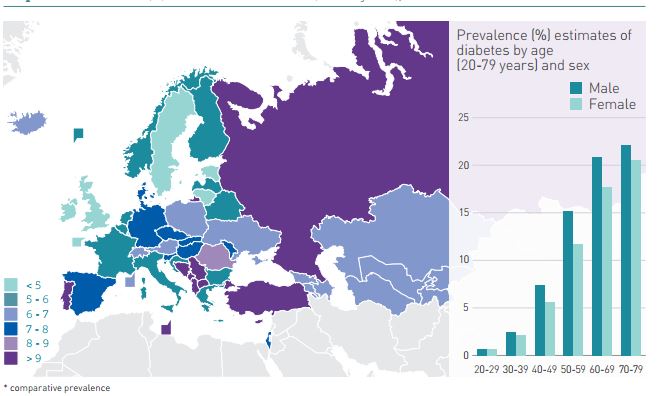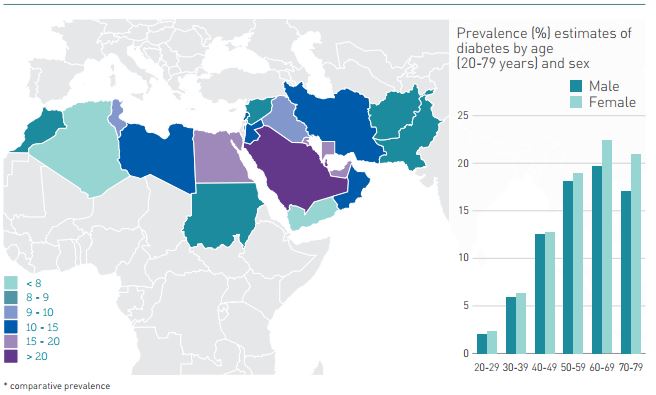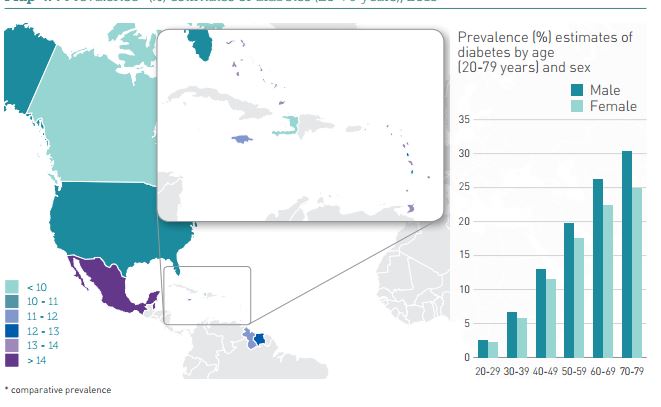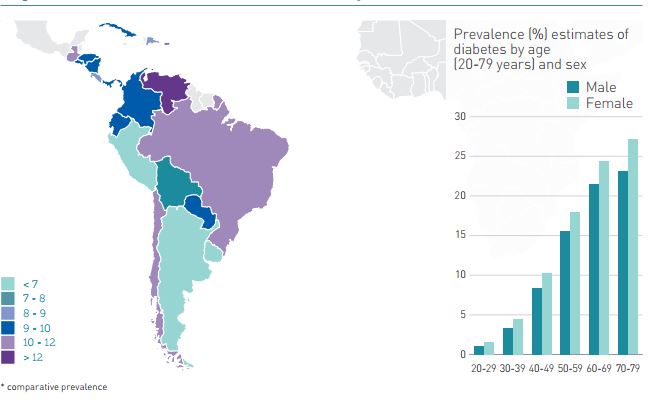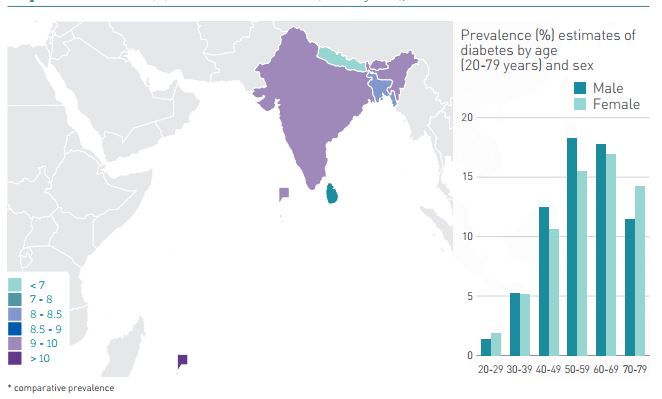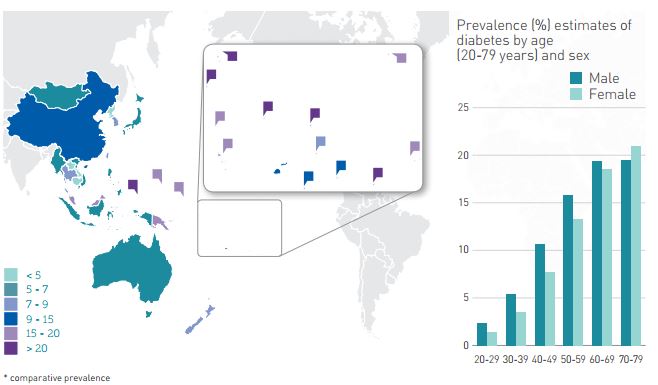Diabetes mellitus type 2 epidemiology and demographics: Difference between revisions
Tarek Nafee (talk | contribs) No edit summary |
No edit summary |
||
| (37 intermediate revisions by 3 users not shown) | |||
| Line 1: | Line 1: | ||
__NOTOC__ | __NOTOC__ | ||
[[Image:IDF2015.JPG|400px|right|thumb|*'''Images are courtsey of The International Diabetes Federation. IDF Diabetes, 7 ed. Brussels, Belgium: International Diabetes Federation, 2015. http://www.diabetesatlas.org''']] | |||
{{Diabetes mellitus type 2}} | {{Diabetes mellitus type 2}} | ||
{{CMG}}; {{AE}}{{DN}};{{TarekNafee}} | {{CMG}}; {{AE}}{{DN}};{{TarekNafee}},{{MehdiP}} | ||
==Overview== | ==Overview== | ||
The prevalence of type 2 diabetes is well studied in the United States and other developed countries. However, worldwide there is a large variation in the results of the population studies in developing countries and particularly in rural areas with poor access to healthcare. For this reason, diabetes is estimated to be undiagnosed in approximately 50% of adults worldwide. In the United States, African Americans, Mexican Americans, American Indians and non-Hispanic blacks are at a higher risk of developing type 2 diabetes compared to non-Hispanic whites. It is more prevalent among those older than 65 years, although there is a growing | The [[prevalence]] of type 2 [[diabetes mellitus]] ([[Diabetes mellitus|DM]]) is well studied in the United States and other developed countries. However, worldwide there is a large variation in the results of the population studies in developing countries and particularly in rural areas with poor access to healthcare. For this reason, [[diabetes]] is estimated to be undiagnosed in approximately 50% of adults worldwide. In the United States, African Americans, Mexican Americans, American Indians and non-Hispanic blacks are at a higher risk of developing [[Diabetes mellitus type 2|type 2 diabetes]] compared to non-Hispanic whites. It is more prevalent among those older than 65 years, although there is a growing trend of childhood-onset of the disease. In 2011, 335 million people were estimated to have [[Diabetes mellitus type 2|type 2 diabetes]] and that number is on a trajectory to reach over 500 million people by 2050. These figures correlate with a [[prevalence]] of approximately 5000 and 7500 per 100,000 in 2011 and 2050, respectively. [[Diabetes mellitus type 2|Type 2 diabetes]] is more prevalent among men than women and in countries with low to mid income levels compared to high income level countries. It is classified as a global epidemic that is growing in parallel to massive urbanization. | ||
==Epidemiology== | ==Epidemiology== | ||
=== Incidence === | |||
* In the United States, approximately 4100 people are diagnosed with [[diabetes]]. 90-95% of these are [[Diabetes mellitus type 2|type 2 diabetes]] diagnoses.<ref name="nature">Zimmet, P., Alberti, K. G. M. M., Shaw, J. Global and societal implications of the diabetes epidemic. ''Nature'' '''2001''', 414, 782-787.</ref> | |||
=== Prevalence === | === Prevalence === | ||
=== Incidence === | * In 2011, about 336 million people had type 2 [[diabetes mellitus]] worldwide. This is approximately 5,000 per 100,000. | ||
In the United States, | * The prevalence of [[diabetes mellitus]] in the U.S is estimated at 7000 to 9,300 per 100,000<ref name="CDC">National Diabetes Statistics Report 2014 http://www.cdc.gov/diabetes/pubs/statsreport14/national-diabetes-report-web.pdf. Accessed on Nov 19, 2016</ref>. Approximately 20% of the population over age 65 have [[Diabetes mellitus type 2|type 2 DM]].<ref name="pmid27733282">{{cite journal| author=GBD 2015 Disease and Injury Incidence and Prevalence Collaborators| title=Global, regional, and national incidence, prevalence, and years lived with disability for 310 diseases and injuries, 1990-2015: a systematic analysis for the Global Burden of Disease Study 2015. | journal=Lancet | year= 2016 | volume= 388 | issue= 10053 | pages= 1545-1602 | pmid=27733282 | doi=10.1016/S0140-6736(16)31678-6 | pmc=5055577 | url=https://www.ncbi.nlm.nih.gov/entrez/eutils/elink.fcgi?dbfrom=pubmed&tool=sumsearch.org/cite&retmode=ref&cmd=prlinks&id=27733282 }} </ref> | ||
=== Mortality rate === | |||
* In 2015, [[diabetes mellitus]] was the seventh leading cause of death in the United States. | |||
* Based on a [[cohort study]] done on 40,286 deaths in patients with [[Diabetes mellitus type 2|type 2 diabetes]], middle age white men lost 5 years and middle age white women lost 6 years of life, compared with non-diabetics. Furthermore, this study revealed that South Asians and blacks with [[diabetes]] lost 1-2 years of life.<ref name="WrightKontopantelis20172">{{cite journal|last1=Wright|first1=Alison K.|last2=Kontopantelis|first2=Evangelos|last3=Emsley|first3=Richard|last4=Buchan|first4=Iain|last5=Sattar|first5=Naveed|last6=Rutter|first6=Martin K.|last7=Ashcroft|first7=Darren M.|title=Life Expectancy and Cause-Specific Mortality in Type 2 Diabetes: A Population-Based Cohort Study Quantifying Relationships in Ethnic Subgroups|journal=Diabetes Care|volume=40|issue=3|year=2017|pages=338–345|issn=0149-5992|doi=10.2337/dc16-1616}}</ref> | |||
== | ==Demographic== | ||
=== Age === | === Age === | ||
The prevalence of type 2 | |||
* The [[prevalence]] of [[Diabetes mellitus type 2|type 2 diabetes mellitus]] is approximately 20% among people older than 65 years old, compared to a [[prevalence]] of approximately 5% in the general population.<ref name="pmid27733282">{{cite journal| author=GBD 2015 Disease and Injury Incidence and Prevalence Collaborators| title=Global, regional, and national incidence, prevalence, and years lived with disability for 310 diseases and injuries, 1990-2015: a systematic analysis for the Global Burden of Disease Study 2015. | journal=Lancet | year= 2016 | volume= 388 | issue= 10053 | pages= 1545-1602 | pmid=27733282 | doi=10.1016/S0140-6736(16)31678-6 | pmc=5055577 | url=https://www.ncbi.nlm.nih.gov/entrez/eutils/elink.fcgi?dbfrom=pubmed&tool=sumsearch.org/cite&retmode=ref&cmd=prlinks&id=27733282 }} </ref><ref name="IDF">{{cite web | |||
| url =http://www.diabetesatlas.org/ | |||
| title = IDF Diabetes Atlas 7th Edition | |||
| location = Brussels, Belgium | |||
| last = | |||
| first = | |||
| date = 2015 | |||
| website =IDF | |||
| publisher = International Diabetes Federation | |||
| access-date = 9 March 2017 | |||
| quote = }}</ref> | |||
=== Race === | |||
* In the United States, the [[prevalence]] of [[diabetes mellitus]] is highest among American Indians and Alaska Natives, followed by non-Hispanic blacks and Mexican Americans. The lowest [[incidence]] of [[diabetes]] in the United States is among the non-Hispanic whites<ref name="pmid24733192">{{cite journal |vauthors=Selvin E, Parrinello CM, Sacks DB, Coresh J |title=Trends in prevalence and control of diabetes in the United States, 1988-1994 and 1999-2010 |journal=Ann. Intern. Med. |volume=160 |issue=8 |pages=517–25 |year=2014 |pmid=24733192 |pmc=4442608 |doi=10.7326/M13-2411 |url=}}</ref><ref name="CDC" />. | |||
* Compared to white diabetics, diabetic South Asians have lower [[mortality rate]] due to [[cardiovascular]] disorders, [[cancer]] and respiratory diseases.<ref name="WrightKontopantelis20173">{{cite journal|last1=Wright|first1=Alison K.|last2=Kontopantelis|first2=Evangelos|last3=Emsley|first3=Richard|last4=Buchan|first4=Iain|last5=Sattar|first5=Naveed|last6=Rutter|first6=Martin K.|last7=Ashcroft|first7=Darren M.|title=Life Expectancy and Cause-Specific Mortality in Type 2 Diabetes: A Population-Based Cohort Study Quantifying Relationships in Ethnic Subgroups|journal=Diabetes Care|volume=40|issue=3|year=2017|pages=338–345|issn=0149-5992|doi=10.2337/dc16-1616}}</ref> | |||
=== Gender === | === Gender === | ||
* [[Diabetes mellitus type 2|Type 2 diabetes mellitus]] is more prevalent in males than females with a ratio of 1.1:1.<ref name="IDF"></ref> | |||
===Socioeconomic Status=== | ===Socioeconomic Status=== | ||
The prevalence of type 2 DM is higher among those with low socioeconomic status. Approximately 75% of patients with diabetes live in low to middle income countries.<ref name="pmid27733282">{{cite journal| author=GBD 2015 Disease and Injury Incidence and Prevalence Collaborators| title=Global, regional, and national incidence, prevalence, and years lived with disability for 310 diseases and injuries, 1990-2015: a systematic analysis for the Global Burden of Disease Study 2015. | journal=Lancet | year= 2016 | volume= 388 | issue= 10053 | pages= 1545-1602 | pmid=27733282 | doi=10.1016/S0140-6736(16)31678-6 | pmc=5055577 | url=https://www.ncbi.nlm.nih.gov/entrez/eutils/elink.fcgi?dbfrom=pubmed&tool=sumsearch.org/cite&retmode=ref&cmd=prlinks&id=27733282 }} </ref> | |||
* The [[prevalence]] of [[Diabetes mellitus type 2|type 2 DM]] is higher among those with low socioeconomic status. Approximately 75% of patients with [[diabetes]] live in low to middle income countries.<ref name="pmid27733282">{{cite journal| author=GBD 2015 Disease and Injury Incidence and Prevalence Collaborators| title=Global, regional, and national incidence, prevalence, and years lived with disability for 310 diseases and injuries, 1990-2015: a systematic analysis for the Global Burden of Disease Study 2015. | journal=Lancet | year= 2016 | volume= 388 | issue= 10053 | pages= 1545-1602 | pmid=27733282 | doi=10.1016/S0140-6736(16)31678-6 | pmc=5055577 | url=https://www.ncbi.nlm.nih.gov/entrez/eutils/elink.fcgi?dbfrom=pubmed&tool=sumsearch.org/cite&retmode=ref&cmd=prlinks&id=27733282 }} </ref><ref name="IDF"></ref> | |||
===Geographic Distribution=== | ===Geographic Distribution=== | ||
The global distribution of diabetes mellitus is reported by the international diabetes foundation. While prevalence of type 2 diabetes is not specifically reported, they do report that the vast majority of diabetes cases are type 2. Additionally, the IDF reports the prevalence of impaired glucose tolerance which alludes to the prevalence of diagnosed and undiagnosed diabetes.<ref name="pmid27733282">{{cite journal| author=GBD 2015 Disease and Injury Incidence and Prevalence Collaborators| title=Global, regional, and national incidence, prevalence, and years lived with disability for 310 diseases and injuries, 1990-2015: a systematic analysis for the Global Burden of Disease Study 2015. | journal=Lancet | year= 2016 | volume= 388 | issue= 10053 | pages= 1545-1602 | pmid=27733282 | doi=10.1016/S0140-6736(16)31678-6 | pmc=5055577 | url=https://www.ncbi.nlm.nih.gov/entrez/eutils/elink.fcgi?dbfrom=pubmed&tool=sumsearch.org/cite&retmode=ref&cmd=prlinks&id=27733282 }} </ref> | |||
* The global distribution of [[diabetes mellitus]] is reported by the international diabetes foundation (IDF). While [[prevalence]] of [[Diabetes mellitus type 2|type 2 diabetes]] is not specifically reported, they do report that the vast majority of [[diabetes]] cases are [[Diabetes mellitus type 2|type 2]]. Additionally, the IDF reports the prevalence of impaired [[glucose]] tolerance which alludes to the prevalence of diagnosed and undiagnosed [[diabetes]].<ref name="pmid27733282">{{cite journal| author=GBD 2015 Disease and Injury Incidence and Prevalence Collaborators| title=Global, regional, and national incidence, prevalence, and years lived with disability for 310 diseases and injuries, 1990-2015: a systematic analysis for the Global Burden of Disease Study 2015. | journal=Lancet | year= 2016 | volume= 388 | issue= 10053 | pages= 1545-1602 | pmid=27733282 | doi=10.1016/S0140-6736(16)31678-6 | pmc=5055577 | url=https://www.ncbi.nlm.nih.gov/entrez/eutils/elink.fcgi?dbfrom=pubmed&tool=sumsearch.org/cite&retmode=ref&cmd=prlinks&id=27733282 }} </ref><ref name="IDF"></ref> | |||
{| class="wikitable" | {| class="wikitable" | ||
!Region | !Region | ||
!Prevalence of Diabetes (per 100,000) | !Prevalence of Diabetes (per 100,000) | ||
!Prevalence of Impaired Glucose Tolerance (per 100,000) | !Prevalence of Impaired Glucose Tolerance (per 100,000) | ||
!Maps | |||
|- | |- | ||
|Africa | |Africa | ||
|3200 | |3200 | ||
|7900 | |7900 | ||
|[[Image:IDFAfrica.JPG]] | |||
|- | |- | ||
|Europe | |Europe | ||
|9100 | |9100 | ||
|4800 | |4800 | ||
|[[Image:IDFEurope.JPG]] | |||
|- | |- | ||
|Middle East and North Africa | |Middle East and North Africa | ||
|9100 | |9100 | ||
|7800 | |7800 | ||
|[[Image:IDFMENA.JPG]] | |||
|- | |- | ||
|North America and Caribbean | |North America and Caribbean | ||
|12900 | |12900 | ||
|15000 | |15000 | ||
|[[Image:IDFNA&C.JPG]] | |||
|- | |- | ||
|South and Central America | |South and Central America | ||
|9400 | |9400 | ||
|7900 | |7900 | ||
|[[Image:IDFS&CA.JPG]] | |||
|- | |- | ||
|Southeast Asia | |Southeast Asia | ||
|8500 | |8500 | ||
|4600 | |4600 | ||
|[[Image:IDFSEA.JPG]] | |||
|- | |- | ||
|Western Pacific | |Western Pacific | ||
|9300 | |9300 | ||
|6200 | |6200 | ||
|[[Image:IDFWP.JPG]] | |||
|} | |} | ||
*'''Images are courtsey of The International Diabetes Federation. IDF Diabetes, 7 ed. Brussels, Belgium: International Diabetes Federation, 2015. http://www.diabetesatlas.org''' | |||
==References== | ==References== | ||
Latest revision as of 20:46, 1 August 2020
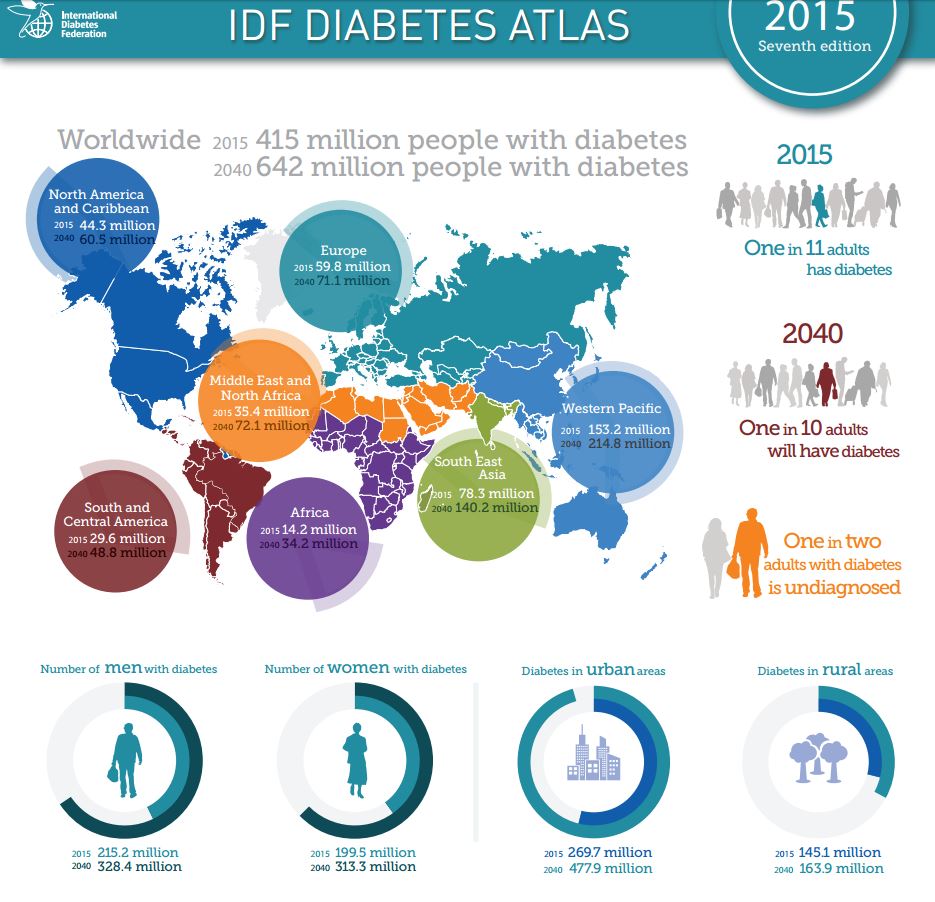
|
Diabetes mellitus type 2 Microchapters |
|
Differentiating Diabetes Mellitus Type 2 from other Diseases |
|
Diagnosis |
|
Treatment |
|
Medical therapy |
Editor-In-Chief: C. Michael Gibson, M.S., M.D. [1]; Associate Editor(s)-in-Chief: Dima Nimri, M.D. [2];Tarek Nafee, M.D. [3],Seyedmahdi Pahlavani, M.D. [4]
Overview
The prevalence of type 2 diabetes mellitus (DM) is well studied in the United States and other developed countries. However, worldwide there is a large variation in the results of the population studies in developing countries and particularly in rural areas with poor access to healthcare. For this reason, diabetes is estimated to be undiagnosed in approximately 50% of adults worldwide. In the United States, African Americans, Mexican Americans, American Indians and non-Hispanic blacks are at a higher risk of developing type 2 diabetes compared to non-Hispanic whites. It is more prevalent among those older than 65 years, although there is a growing trend of childhood-onset of the disease. In 2011, 335 million people were estimated to have type 2 diabetes and that number is on a trajectory to reach over 500 million people by 2050. These figures correlate with a prevalence of approximately 5000 and 7500 per 100,000 in 2011 and 2050, respectively. Type 2 diabetes is more prevalent among men than women and in countries with low to mid income levels compared to high income level countries. It is classified as a global epidemic that is growing in parallel to massive urbanization.
Epidemiology
Incidence
- In the United States, approximately 4100 people are diagnosed with diabetes. 90-95% of these are type 2 diabetes diagnoses.[1]
Prevalence
- In 2011, about 336 million people had type 2 diabetes mellitus worldwide. This is approximately 5,000 per 100,000.
- The prevalence of diabetes mellitus in the U.S is estimated at 7000 to 9,300 per 100,000[2]. Approximately 20% of the population over age 65 have type 2 DM.[3]
Mortality rate
- In 2015, diabetes mellitus was the seventh leading cause of death in the United States.
- Based on a cohort study done on 40,286 deaths in patients with type 2 diabetes, middle age white men lost 5 years and middle age white women lost 6 years of life, compared with non-diabetics. Furthermore, this study revealed that South Asians and blacks with diabetes lost 1-2 years of life.[4]
Demographic
Age
- The prevalence of type 2 diabetes mellitus is approximately 20% among people older than 65 years old, compared to a prevalence of approximately 5% in the general population.[3][5]
Race
- In the United States, the prevalence of diabetes mellitus is highest among American Indians and Alaska Natives, followed by non-Hispanic blacks and Mexican Americans. The lowest incidence of diabetes in the United States is among the non-Hispanic whites[6][2].
- Compared to white diabetics, diabetic South Asians have lower mortality rate due to cardiovascular disorders, cancer and respiratory diseases.[7]
Gender
- Type 2 diabetes mellitus is more prevalent in males than females with a ratio of 1.1:1.[5]
Socioeconomic Status
- The prevalence of type 2 DM is higher among those with low socioeconomic status. Approximately 75% of patients with diabetes live in low to middle income countries.[3][5]
Geographic Distribution
- The global distribution of diabetes mellitus is reported by the international diabetes foundation (IDF). While prevalence of type 2 diabetes is not specifically reported, they do report that the vast majority of diabetes cases are type 2. Additionally, the IDF reports the prevalence of impaired glucose tolerance which alludes to the prevalence of diagnosed and undiagnosed diabetes.[3][5]
- Images are courtsey of The International Diabetes Federation. IDF Diabetes, 7 ed. Brussels, Belgium: International Diabetes Federation, 2015. http://www.diabetesatlas.org
References
- ↑ Zimmet, P., Alberti, K. G. M. M., Shaw, J. Global and societal implications of the diabetes epidemic. Nature 2001, 414, 782-787.
- ↑ 2.0 2.1 National Diabetes Statistics Report 2014 http://www.cdc.gov/diabetes/pubs/statsreport14/national-diabetes-report-web.pdf. Accessed on Nov 19, 2016
- ↑ 3.0 3.1 3.2 3.3 GBD 2015 Disease and Injury Incidence and Prevalence Collaborators (2016). "Global, regional, and national incidence, prevalence, and years lived with disability for 310 diseases and injuries, 1990-2015: a systematic analysis for the Global Burden of Disease Study 2015". Lancet. 388 (10053): 1545–1602. doi:10.1016/S0140-6736(16)31678-6. PMC 5055577. PMID 27733282.
- ↑ Wright, Alison K.; Kontopantelis, Evangelos; Emsley, Richard; Buchan, Iain; Sattar, Naveed; Rutter, Martin K.; Ashcroft, Darren M. (2017). "Life Expectancy and Cause-Specific Mortality in Type 2 Diabetes: A Population-Based Cohort Study Quantifying Relationships in Ethnic Subgroups". Diabetes Care. 40 (3): 338–345. doi:10.2337/dc16-1616. ISSN 0149-5992.
- ↑ 5.0 5.1 5.2 5.3 "IDF Diabetes Atlas 7th Edition". IDF. Brussels, Belgium: International Diabetes Federation. 2015. Retrieved 9 March 2017.
- ↑ Selvin E, Parrinello CM, Sacks DB, Coresh J (2014). "Trends in prevalence and control of diabetes in the United States, 1988-1994 and 1999-2010". Ann. Intern. Med. 160 (8): 517–25. doi:10.7326/M13-2411. PMC 4442608. PMID 24733192.
- ↑ Wright, Alison K.; Kontopantelis, Evangelos; Emsley, Richard; Buchan, Iain; Sattar, Naveed; Rutter, Martin K.; Ashcroft, Darren M. (2017). "Life Expectancy and Cause-Specific Mortality in Type 2 Diabetes: A Population-Based Cohort Study Quantifying Relationships in Ethnic Subgroups". Diabetes Care. 40 (3): 338–345. doi:10.2337/dc16-1616. ISSN 0149-5992.
